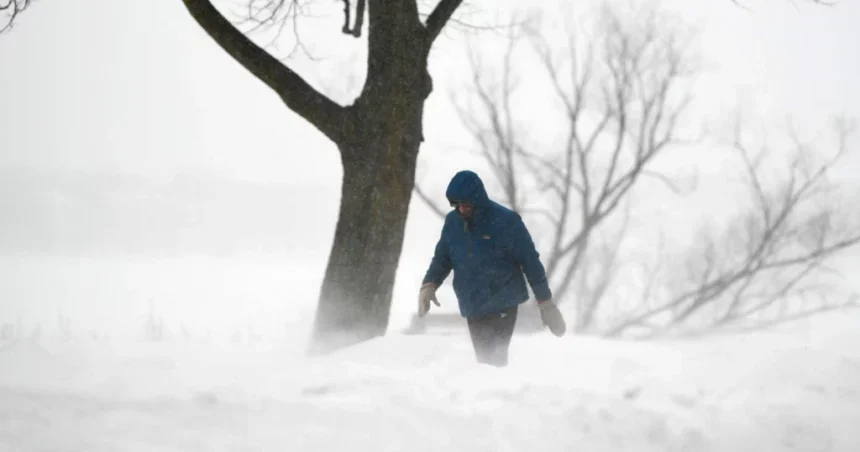Winter is here, and with it comes the beauty of snow-covered landscapes in Northern Minnesota and Northwest Wisconsin. However, along with the picturesque scenes, winter also brings its fair share of challenges. As a Winter Weather Advisory has been issued for these regions, it’s essential to understand what this means and how you can best prepare for the impending severe weather conditions. Let’s dive into what a Winter Weather Advisory entails and explore some crucial tips to help you stay safe during this wintery blast!
What is a Winter Weather Advisory?
A Winter Weather Advisory is a notification issued by the National Weather Service to alert the public about impending winter weather conditions that could cause inconvenience or pose risks. It falls in between a Winter Storm Watch and a more severe warning. This advisory signifies that snow, sleet, freezing rain, or other wintry precipitation is expected but not at warning levels.
The purpose of a Winter Weather Advisory is to prompt individuals to take precautions and prepare for the anticipated weather event. It serves as a heads-up for potentially hazardous conditions that may impact travel, daily activities, and overall safety. By being aware of this advisory, you can make informed decisions on how to navigate through the upcoming winter weather system.
It’s important to pay attention to updates from local authorities and meteorologists regarding specific details about timing, duration, and intensity of the forecasted winter weather. Being proactive in response to a Winter Weather Advisory can help minimize disruptions and ensure your well-being during challenging winter conditions.
Understanding Winter Storms in Northern Minnesota and Northwest Wisconsin
Winter storms in Northern Minnesota and Northwest Wisconsin can be fierce and unpredictable. These regions are no stranger to heavy snowfall, strong winds, and plummeting temperatures during the winter months. The combination of these factors often leads to hazardous conditions that require careful preparation and awareness.
Understanding the dynamics of winter storms is crucial for residents in these areas. These storms typically develop when cold air masses collide with warm air currents, resulting in a mix of precipitation that can range from light flurries to blizzards. The intensity of a winter storm can vary greatly, making it essential to stay informed about weather updates and advisories.
Factors such as lake-effect snow from Lake Superior can amplify snowfall amounts in certain areas, adding an extra layer of complexity to forecasting winter weather events. With proper knowledge and preparedness, individuals living in Northern Minnesota and Northwest Wisconsin can navigate through winter storms safely.
Essential Preparation Tips for Severe Winter Weather
When a winter weather advisory is issued for Northern Minnesota and Northwest Wisconsin, it’s crucial to be prepared for severe winter conditions. Here are some essential preparation tips to help you stay safe during the storm.
Make sure your home is well-insulated and stocked with emergency supplies like food, water, blankets, flashlights, and batteries. It’s also important to have a battery-powered radio or phone charger in case of power outages.
Additionally, prepare your vehicle by checking the antifreeze levels, tire pressure, and ensuring you have an emergency kit in the car. This kit should include items like a shovel, windshield scraper, jumper cables, and extra clothing.
Furthermore, dress warmly in layers and limit time spent outdoors during extreme cold temperatures. Stay informed about the weather forecast and any updates from local authorities to ensure you’re ready for whatever Mother Nature throws your way.
Staying Safe During a Winter Weather Advisory
When a Winter Weather Advisory is issued for Northern Minnesota and Northwest Wisconsin, it’s crucial to prioritize safety. One of the key ways to stay safe during severe winter weather is by staying indoors whenever possible. The frigid temperatures and icy conditions can pose serious risks if you’re not adequately prepared.
Make sure your home is well-stocked with essential supplies like food, water, blankets, and flashlights in case of power outages. If you must go outside, layer up with warm clothing and ensure all exposed skin is covered to prevent frostbite. It’s also important to limit time spent outdoors to avoid dangerous wind chills.
Keep an eye on weather updates and warnings from local authorities to stay informed about changing conditions. By taking these precautions seriously and being proactive in your approach to staying safe during a Winter Weather Advisory, you can help mitigate potential risks associated with severe winter storms.
Impact on Travel and Road Conditions
Travel and road conditions in Northern Minnesota and Northwest Wisconsin can take a drastic turn during a winter weather advisory. Snow, ice, and strong winds can make roads slippery and visibility poor, posing significant challenges for drivers.
The impact on travel is not limited to just the roads; airports may experience delays or cancellations due to the severe weather conditions. It’s crucial to stay updated on any travel advisories issued by authorities.
During a winter storm, it’s advisable to avoid unnecessary travel if possible. If you must go out, make sure your vehicle is equipped with proper winter tires, emergency supplies like blankets and food, and always drive cautiously.
Road crews work tirelessly to plow snow and apply salt to improve road conditions, but it’s essential for drivers to exercise caution and patience while navigating through potentially hazardous areas. Remember that safety should always be the top priority when traveling during inclement weather conditions.
How to Stay Informed and Updated during a Winter Storm
During a winter storm, staying informed and updated is crucial to ensure your safety and well-being. One of the best ways to do this is by tuning into local weather forecasts on TV, radio, or online platforms. Meteorologists provide real-time updates on changing weather conditions, advisories, and warnings specific to your area.
Additionally, signing up for emergency alerts from your county or state can keep you informed about any immediate threats or evacuation notices. These alerts are sent directly to your phone via text message or through dedicated apps.
Following official social media accounts of relevant authorities such as the National Weather Service or local law enforcement agencies can also provide valuable information during a winter storm. They often share important updates, road closures, and safety tips in real-time.
Having a battery-powered radio handy can be beneficial in case of power outages that may disrupt other communication channels. By utilizing these resources effectively, you can stay informed and make well-informed decisions during severe winter weather events.
Conclusion
Being prepared and staying informed are key when facing a winter weather advisory in Northern Minnesota and Northwest Wisconsin. By understanding what a winter weather advisory entails, knowing how to prepare for severe winter storms, and staying safe during adverse conditions, you can navigate the challenges that come with inclement weather more effectively. Remember to stay updated on travel advisories and road conditions to ensure your safety and the safety of others. Stay warm, stay safe, and be prepared for whatever winter may bring in these regions.

